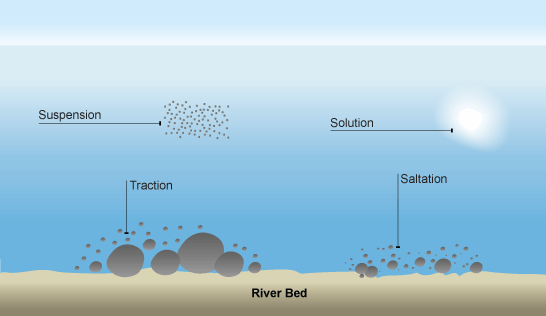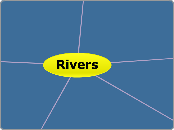Rivers
River System
A river is a body of water flowing in a channel.
Due to gravity, water always flows downhill from it's source.
As it flows downhill, it travels along a path known as its course
The course of a river may be divided into three parts.
Upper course
The gradient or slope of the river is usually steep
The channel tends to be narrow and shallow, only a small amount of water transported.
The upper course is nearer to the source of the river.
Middle course
The river channel is much wider as other smaller rivers or streams may join the main river. These smaller rivers and streams are known as tributaries
The gradient of the slope is not as steep as the upper course.
Lower course
The gradient of the river is very gentle
The river channel is wider than the upper course of the river
The volume of water increase as more tributaries have joined the main river along the way
It begins at its source
This source may be a lake or melting snow
This source usually located in mountains or highlands
The river ends in a lake,sea,or an ocean
The part of the river that enters the sea is known as the river mouth
A river, together with its network of tributaries, lies within a drainage basin.
A drainage basin is the land area drained by the main river and its tributaries.
A watershed separates one drainage basin from the next drainage basin, acting as a boundary which is marked by the crests of hill ridges and mountains
River System
Mangemment of River Channels
Channelisation
Re-alignment
Re-sectioning
Bank protection
Bank protection
Energy of a River
The energy of a river is determined by the speed of the river and the volume of the river.
When the speed and volume of the river are high, the energy of the river will be high.
If the speed of the river is low, the energy of the river will be low.
THe energy of a river changes along its course because the speed and volume of a river changes as its flows through its upper, middle, and lower course
This changes occur as factors that affect the speed and the volume of a river.
Factors involving the speed of a river
Gradient of channel
River flows downhill from a high altitude due to gravity, The speed at whcich a river does so depends very much on the steepness of the channel
If the gradient is gentle the river will flow slowly.
If the gradient is steep, the river will flow quickly.
roughness of the channel
As water flows through a river's channel, it encounter obstacles such as rocks, boulders, underwater vegetation or an uneven river bed. These obstacles cause friction between the water and the channel. This friction will slow down the river flow and reduce the speed of the river. Therefore, a river with a smoother channel will have a higher speed than a river with a rougher channel
Wetted perimeter
River channels can be of various shapes ands sizes the sope of a river channel affects the wetted perimeter, which is the length and breath of the channel in contact with the river's water. If the wetted perimeter is large, more water comes into contact of with the channel. Thus, a lot of friction is generated as the river flows along channel. Friction is genearted as the river flows along a channel. Friction causes the river to flow more slowly. On the other hand ,if the wetted perimeter is small, less friction is generated and hence the river will tend to flow faster.
Factors affecting the volume of water in a river .
Presence of vegetation
Vegetation intercepts rain and allows more water to infiltrate or seep into the ground. Hence abundunt vegetation allows more rain water to infiltrate into the ground, there by reducing flow into the river and the volume of water is smaller. sparce vegetation does not allow much rainwater to infiltrate the ground,thus increasing the flow of surface runoff.
Thus, more surface runoff flows into the river and the volume of the river is larger
Size of drainage basin
The bigger the drainage area, the greater will the amount of water in a river because when the drainage are is large, there is more surface area for rain to fall on. The rain flows over the land as surface runoff or seeps into the ground before eventually reaching the river.
Smaller drainage areas have less volume of water in a river
Permeability of rocks
There is a high tendency for rain failling onto an area with permeable rocks.
A river flowing in an area with less permeable rocks will most probably have a larger volume of water in its channel comapred to a river flowing in an area with more permeable rocks
Climate
The climate of the area in which a river flows flows can also affect the volume of water in its channel.
In areas with the distinct wet and dry seasons, the amount of water in the channel fluctuates accourding to the amount of rain fall recieved during each season. In other areas which are generally dry
The energy of the river determines the ability of the river to erode, transport or deposit materials
Landforms Formed by River Processes
Waterfalls
Waterfalls are sudden, steep, vertical flows of fast flowing water falling from great heights.
Gorges
Valleys
Tributaries
River Processess
The energy of a river determines the kind of process that the river moves along its course.
When tthe river has high energy, it is able to erode rocks and other materials in its path.
The river may transport the other materials until it loses its energy and deposits them on the river bed.
Erosion
As rivers flow downstream, pieses of rock are removed from the river bed and banks, and moved along the river channel
This causes the river channel to deepen and widen
Vertical erosion
Rocks and other materials on the river bed and other materials on the river bed is removed and causes the channel to deepen
Lateral erosion
When Rocks and other materials along the sides of the channel are worn away and cause the river channel to become wider.
Erosion processes
Hrdraulic action
As the force or energy of fast moving water is strong enough to loosen the rocks and soil are dislodged and carried down the river. The river channel is eroded as a result.
Corrasion / Abrasion
Rock fragments are dragged along the river bed or against the river banks. This grinding action causes the river channel to widden and deepenas rocks and soil are scrapped off the sides and bottom, and carried away with the water.
Attrition
The river carries a load of eroded materials which contain rock fragments and other materials
These materials constantly collid woth one another as they move. Over time the materials breaks down into smaller pieces.
Larger rocks are slowly broken down into smaller pieces, and the rough edges have smoothen out.
Solution
Rainwater reacts with carbon dioxide and form carbonic acid. Carbonic acid dissolves materials present in the rocks on the river bed and banks.
When a river with carbonic acid flows over limestone, a chemical reacton dissolves the calcium carbonate to form calcuim bicarbonate.
Transportaton
When a river has sufficient energy, materials will be carried or transported downstream.
Four different transport processes
Traction
Large sized materials such as boulders, pebbles and gravel are found rolling or sliding along the river bed
Saltation
Movements of material downstream in a series of bouncing movements
Smaller materials such as coarse sand particles, move along the river by lifting up and dropping to the river bed
Suspension
Finer particles such as silt, clay and sand are carried along the river without touching the river bed.
These materials are held in suspension of the river, they form the greatest proportion of the river's load and give the river a murky appearance
Solution
Finer materials such as calcuim carbonate are dissolved in the river and would continue to transport them downstream

Solution
Deposition
When a river does not not have enough energy to erode or transport material. it deposits the load that its carrying.
